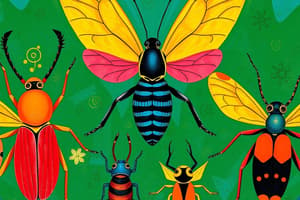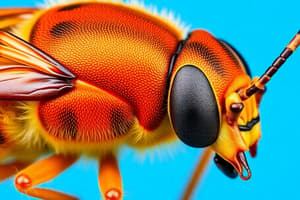Podcast
Questions and Answers
What is the order Ephemeroptera known for?
What is the order Ephemeroptera known for?
- Cockroaches
- Dragonflies
- Termites
- Mayflies (correct)
What is the definition of Plecoptera?
What is the definition of Plecoptera?
Soft bodied and similar to Ephemeroptera and lay thousands of eggs.
Which of the following characteristics belong to the order Odonata?
Which of the following characteristics belong to the order Odonata?
- Social insects
- Complete metamorphosis
- Large triangular forewing
- Four elongated membranous wings (correct)
What insect order is known as Phasmida?
What insect order is known as Phasmida?
What are Blattodea commonly known as?
What are Blattodea commonly known as?
What is the notable feature of Mantodea?
What is the notable feature of Mantodea?
Which order is known for its forceps-like cerci?
Which order is known for its forceps-like cerci?
What distinguishes Isoptera?
What distinguishes Isoptera?
What is Thysanura commonly known as?
What is Thysanura commonly known as?
Which order includes true flies?
Which order includes true flies?
What defines Hemiptera?
What defines Hemiptera?
What is the order Neuroptera characterized by?
What is the order Neuroptera characterized by?
What distinguishes Coleoptera?
What distinguishes Coleoptera?
What type of insects does Siphonoptera refer to?
What type of insects does Siphonoptera refer to?
What is the main characteristic of Lepidoptera?
What is the main characteristic of Lepidoptera?
What order do caddisflies belong to?
What order do caddisflies belong to?
What does Hymenoptera include?
What does Hymenoptera include?
What are Orthoptera commonly known for?
What are Orthoptera commonly known for?
What does the term Megaloptera mean?
What does the term Megaloptera mean?
Flashcards are hidden until you start studying
Study Notes
Insect Orders Overview
-
Ephemeroptera:
- Commonly known as mayflies.
- Characterized by large, triangular forewings that cannot fold, held tent-like above the body when at rest.
-
Plecoptero:
- Soft-bodied insects similar to mayflies.
- Known for laying thousands of eggs.
-
Odonata:
- Includes dragonflies and damselflies.
- Features four elongated membranous wings with veins and very large compound eyes.
- Incomplete metamorphosis with aquatic naiads; dragonflies hold wings straight out, while damselflies hold them parallel to the body.
-
Phasmida:
- Consists of stick insects, sometimes classified under Orthoptera.
-
Blattodea:
- Comprises cockroaches; name derived from the Greek "blatta."
- Exhibits gradual metamorphosis with leathery, often reduced wings and chewing mouthparts.
- Omnivorous diet, cursorial legs enable fast running.
- Some species are household pests, mostly tropical and outdoor dwellers, with certain species displaying social behavior.
- Eggs are produced in "egg cases" called ootheca.
-
Mantodea:
- Known as praying mantids, signifying "soothsayer" or "prophet."
- Features gradual metamorphosis, leathery forewings, and raptorial front legs for predation.
- Lays eggs in ootheca.
-
Dermaptera:
- Commonly referred to as earwigs, with a name meaning "skin wing."
- Exhibits gradual metamorphosis, two pairs of wings (front pair leathery), and forceps-like cerci.
- Mostly omnivorous and can be considered nuisance pests.
-
Isoptera:
- Known as termites, meaning "equal wings," living in social groups with a caste system.
- Features gradual metamorphosis; worker termites lack wings.
- Chewing mouthparts; structural pests often aided by symbiotic microorganisms for cellulose digestion.
-
Thysanura:
- Comprises silverfish and firebrats, denoting "fringed tail."
- Flattened body covered with scales and lacks metamorphosis; primitively wingless.
- Equipped with chewing mouthparts and three "tails," serving as omnivores.
-
Diptera:
- True flies characterized by a single pair of wings and specialized sucking or piercing mouthparts.
-
Hemiptera:
- Known as true bugs; defined by their half wings and X-shaped marking on the back.
-
Neuroptera:
- Includes lacewings recognized for their membranous wings.
-
Coleoptera:
- Beetles identified by two horny wings and two membranous wings.
-
Siphonoptera:
- Comprises fleas, which are parasitic insects.
-
Lepidoptera:
- Encompasses butterflies and moths, distinguished by scaled wings and possessing a proboscis for sucking.
-
Trichoptera:
- Known as caddisflies, noted for their resemblance to Lepidoptera and recognized as one of the most diverse insect orders.
-
Hymenoptera:
- An order including bees and wasps, known for their complex social behaviors.
-
Orthoptera:
- Comprising grasshoppers and crickets, characterized by large back legs adapted for jumping.
-
Megaloptera:
- Meaning "large wing," includes dobsonflies and alderflies, with larvae featuring lateral filaments.
Studying That Suits You
Use AI to generate personalized quizzes and flashcards to suit your learning preferences.




